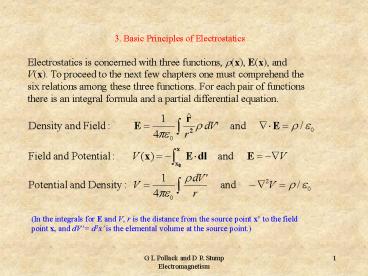3. Basic Principles of Electrostatics - PowerPoint PPT Presentation
1 / 2
Title:
3. Basic Principles of Electrostatics
Description:
For each pair of functions there is an integral formula and a partial differential equation. ... (In the integrals for E and V, r is the distance from the source ... – PowerPoint PPT presentation
Number of Views:73
Avg rating:3.0/5.0
Title: 3. Basic Principles of Electrostatics
1
3. Basic Principles of Electrostatics
Electrostatics is concerned with three functions,
?(x), E(x), and V(x). To proceed to the next few
chapters one must comprehend the six relations
among these three functions. For each pair of
functions there is an integral formula and a
partial differential equation.
(In the integrals for E and V, r is the distance
from the source point x to the field point x,
and dV d3x is the elemental volume at the
source point.)
2
Use of Gausss Theorem (Figure 3.8)
By Gausss theorem, the flux of E through a
closed surface S is equal to Q/?0 where Q is the
charge enclosed. For a charge distribution with
spherical, cylindrical or planar symmetry, E(x)
can be determined.
- For spherical symmetry, apply Gausss theorem to
a spherical surface around the center of
symmetry the flux of E is Er(r)?4? r2. - For cylindrical symmetry use a cylindrical
gaussian surface around the line of symmetry the
flux of E is Er(R)?2? Rh. - For planar symmetry use a cylindrical gaussian
surface with the end-caps at equal distances
above and below the plane of symmetry the flux
of E is 2Ez(z)? A.

